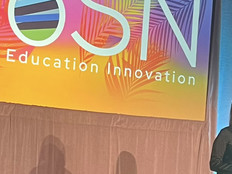Google Champions Teacher Tech Training with New Program
While internet connectivity has made its way into more schools than ever, a new digital divide has emerged — this time for teachers. Education Week’s Technology Counts 2017 survey found that teachers in high-poverty schools consistently receive less technology-integration training than teachers in wealthier schools.
In an effort to combat this divide, Google, Digital Promise and EdTechTeam have partnered to launch the Dynamic Learning Project.
The program, which began in July, provides 50 schools in low-income communities in five states (Alabama, California, South Carolina, Pennsylvania and Texas) with a full-time technology coach at each school. Teachers are not just learning to use Google’s technology at a deeper level; coaches help teachers use any type of education technology that interests them.
Using a $6.5 million grant provided by Google, Digital Promise will study the effectiveness of a professional development strategy based on the coaching model, while EdTechTeam will provide the coaches with ongoing professional development and mentoring.
SIGN UP: Get more news from the EdTech newsletter in your inbox every two weeks!
Tackling the Second Level of the Digital Divide
Karen Cator, president and CEO of Digital Promise, explains that while the digital divide — where some schools have access to technology and some don’t — still exists, a second-level digital divide has emerged.
“Even after schools started to implement technology, we started seeing this second-level digital divide which is in the quality and depth of usage in the technology,” explains Cator.
Cator and her colleagues hope that by providing rich one-on-one technology training for teachers in low-income schools more educators can start using technology in ways that encourage powerful learning and deep engagement in students.
“That’s what the second-level digital divide is all about: helping people use technology in powerful ways to support learning,” says Cator.
Schools Find Digital Success with More Support
Although it’s still early days, some participating schools report that the coaching approach to tech training is already having an impact.
Teachers at Oxford Middle School in Oxford, Ala. have implemented a genius hour, they’ve dubbed “Dynamo Hour,” where they spend an hour a week working with colleagues on plans to increase students’ ownership in learning.
Some are encouraging students to reflect on their learning through blogging and videos while others are focusing on differentiation, allowing students to participate in decisions around how they learn best and how they demonstrate their learning.
At Liberty Junior High in Dallas, Texas, Dynamic Learning coach, Caree Rahberg, says that while she provided technology training in her former role as the school’s librarian, her new role allows her to provide teachers with deeper, more effective training.
“What I didn’t realize is that I could train them, but they would go back in their classroom and they couldn’t actually apply it because there was no one there to do the work of coaching them on ‘How do you upload it into Google Classroom? Etc.,’” says Rahberg. “Now because I’m in the classroom, it’s made me more able to give them that ‘just-in-time’ coaching or assistance they need so they can be successful.”
Schools interested in participating in the second year of the Dynamic Learning Project can fill out a form here.








